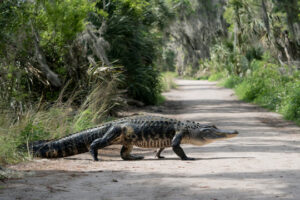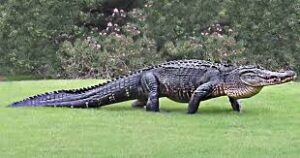In the murky waters and swampy landscapes that define their habitat, alligators reign supreme as ancient predators, capturing the imagination with their prehistoric allure. Yet, beyond their menacing presence in the water, curiosity lingers about the terrestrial capabilities of these reptilian giants. The question arises: How fast can alligators run?
Alligators are not known for their impressive speed on land compared to some other animals. On average, alligators can run at speeds of around 9 to 11 miles per hour (15 to 18 kilometers per hour) for short distances.
Their terrestrial mobility is not their primary strength; instead, they are well-adapted for efficient movement in aquatic environments.
How fast can alligators run?

Alligators are surprisingly quick on land, despite their bulky appearance! They can reach impressive speeds in short bursts, though their stamina isn’t quite as impressive.
Here’s a breakdown of their running abilities:
Top Speed:
While some reports claim bursts of up to 35 mph (56 km/h), most reliable sources agree that alligators can typically reach speeds of 20-30 mph (32-48 km/h) over short distances. That’s almost as fast as a galloping horse.
Average Speed:
However, this isn’t their usual pace. For sustained distances, alligators average around 9.5-11 mph (15-18 km/h). This is still faster than the average human’s running speed, so it’s important to remember that you shouldn’t try to outrun an alligator on land unless you have a significant head start.
Factors Affecting Speed: Several factors can influence an alligator’s running speed, including:
- Age: Younger alligators tend to be faster than older ones.
- Size: Larger alligators are generally slower than smaller ones.
- Terrain: Alligators run faster on smooth surfaces like grass or sand than on rough terrain like rocks or logs.
- Temperature: Alligators are cold-blooded, so they move slower in colder weather.
Comparison to Humans: While alligators can outrun humans in short bursts, most humans can outrun them over longer distances. So, if you ever encounter an alligator on land, the best strategy is to run away in a straight line, not a zigzag. This will make it harder for the alligator to change direction and catch you.
It’s important to remember that even though alligators are relatively slow on land, they are still dangerous predators. Never approach or provoke an alligator, and always maintain a safe distance.
Alligator Locomotion
Alligators are fascinating creatures known for their distinctive appearance and unique behaviors. When it comes to locomotion, alligators are quite versatile and can move in various ways both on land and in water.
Here are the primary modes of alligator locomotion:
- Walking on Land:
- Alligators are capable of “belly crawling” on land. They use a sprawling gait, where their limbs are positioned more to the side of the body.
- The legs move in a lateral (side-to-side) motion, and the alligator drags its belly along the ground.
- This form of movement is relatively slow, and alligators are not well-adapted for fast terrestrial travel.
- Swimming:
- Alligators are well-adapted swimmers and are often found in aquatic environments.
- They use a serpentine swimming motion, where their bodies undulate from side to side.
- Their tails are powerful and contribute significantly to propulsion through the water.
- Submerged Locomotion:
- Alligators are also capable of moving stealthily through the water while remaining mostly submerged.
- They use their tails to generate forward thrust and can move with minimal disturbance on the water’s surface.
- Basking and Sliding:
- Alligators often bask in the sun to regulate their body temperature. They may use their legs to push themselves onto riverbanks or logs.
- Sometimes, alligators are observed sliding into the water from an elevated position, using a combination of gravity and their bodies to move.
Additionally, alligators are ambush predators, and their movements are generally characterized by short bursts of speed rather than sustained endurance. They are well-adapted to their semi-aquatic environments, utilizing different modes of locomotion based on their immediate needs and surroundings.
Factors Influencing Alligator Speed

The speed of an alligator is influenced by various factors, including its size, age, health, and the context of its movement. Here are some key factors that can influence an alligator’s speed:
- Size and Age:
- Larger alligators tend to move more slowly than smaller ones. The size and weight of an alligator affect its ability to accelerate and sustain speed.
- Younger alligators are generally more agile and may be faster than older, larger individuals.
- Temperature and Metabolism:
- Alligators are ectothermic, meaning their body temperature is influenced by the external environment. Warmer temperatures can increase their metabolism and potentially enhance their activity levels.
- In cooler temperatures, alligators may move more slowly as their metabolic processes slow down.
- Terrain:
- The type of terrain an alligator is moving on can impact its speed. Alligators are more adapted to aquatic environments, where they can use their powerful tails for propulsion in the water.
- On land, they are less agile, and their movement is typically slower compared to their swimming abilities.
- Behavioral State:
- Alligators are known for their ambush hunting strategy. They may remain motionless for long periods and then exhibit a burst of speed when capturing prey.
- The speed at which an alligator moves can also be influenced by its alertness, whether it’s in a defensive or aggressive state, or if it’s engaged in activities like courtship.
- Health and Physical Condition:
- The overall health and physical condition of an alligator can affect its ability to move quickly. A healthy alligator with optimal muscle function and coordination may be more agile than one facing health issues.
- Purpose of Movement:
- The reason an alligator is moving can influence its speed. If it’s in pursuit of prey or escaping a potential threat, it may move more quickly. However, if it’s casually exploring or basking, it might move at a slower pace.
- Environmental Conditions:
- Factors such as water current, wind, and the presence of obstacles in the environment can impact an alligator’s speed. In water, they can leverage currents for faster movement, while obstacles may slow them down.
Importance of Alligator Speed

The speed of alligators plays a significant role in their survival, hunting strategies, and overall ecological niche. Here are several aspects highlighting the importance of alligator speed:
- Ambush Predation:
- Alligators are ambush predators, relying on stealth and sudden bursts of speed to capture prey. Their ability to move quickly in water is crucial for surprising and catching animals that come near the water’s edge.
- Hunting Efficiency:
- Alligators often hunt by lying in wait near the water’s surface. When prey comes within striking distance, the alligator can swiftly launch itself to capture it. Speed is essential for this predatory strategy to be effective.
- Escape and Defense:
- Alligators need speed to escape from potential threats or danger. Whether facing a larger predator, human disturbance, or other threats, the ability to quickly move in water or on land can be critical for their survival.
- Territorial Movement:
- Alligators may need to cover distances within their territories for various reasons, such as finding suitable basking spots, mating opportunities, or searching for food. The ability to move efficiently aids in their territorial behaviors.
- Navigating Different Environments:
- Alligators inhabit a range of environments, from slow-moving rivers to swamps and lakes. Their ability to adjust their speed based on the specific environment allows them to navigate through various terrains and water conditions.
- Thermoregulation:
- Alligators regulate their body temperature through basking in the sun. Their speed in climbing onto riverbanks or logs for basking is important for maintaining optimal body temperature, especially in cooler weather.
- Mating Rituals:
- During the mating season, alligators engage in courtship rituals that involve movement and displays. The speed at which they can navigate and interact with potential mates is crucial for successful reproduction.
- Optimizing Energy Expenditure:
- Alligators are ectothermic, meaning they rely on external sources of heat for thermoregulation. Moving efficiently allows them to optimize energy expenditure, conserving energy for essential activities like hunting and reproduction.
- Adaptation to Dynamic Environments:
- Alligators often live in environments with changing water levels, currents, and weather conditions. Their ability to adjust their speed and movement patterns enables them to adapt to dynamic and sometimes unpredictable surroundings.
How alligator speed compares with land animals
Alligators are not known for their speed on land; they are primarily adapted for aquatic environments. On land, alligators are relatively slow and cumbersome. They can move quickly in short bursts but are not built for sustained, high-speed running. On average, an alligator’s land speed is estimated to be around 5 to 9 miles per hour (8 to 14 km/h).
Comparatively, many land animals are much faster than alligators. For example, cheetahs, the fastest land animals, can reach speeds of up to 60 to 70 miles per hour (97 to 113 km/h) in short sprints. Other animals, like horses, lions, and various antelope species, are also capable of reaching higher speeds on land compared to alligators.
It’s important to note that alligators are well-adapted predators in aquatic environments, where they excel at swimming and ambushing prey. In water, they can move stealthily and swiftly, using their powerful tails for propulsion.
Conclusion
Alligators are not known for their speed on land; their average land speed is estimated to be around 5 to 9 miles per hour (8 to 14 km/h). How fast can alligators run makes them relatively slow and cumbersome compared to many land animals.
In addition, alligators are primarily adapted for aquatic environments, where they showcase agility and speed in the water rather than on land.

